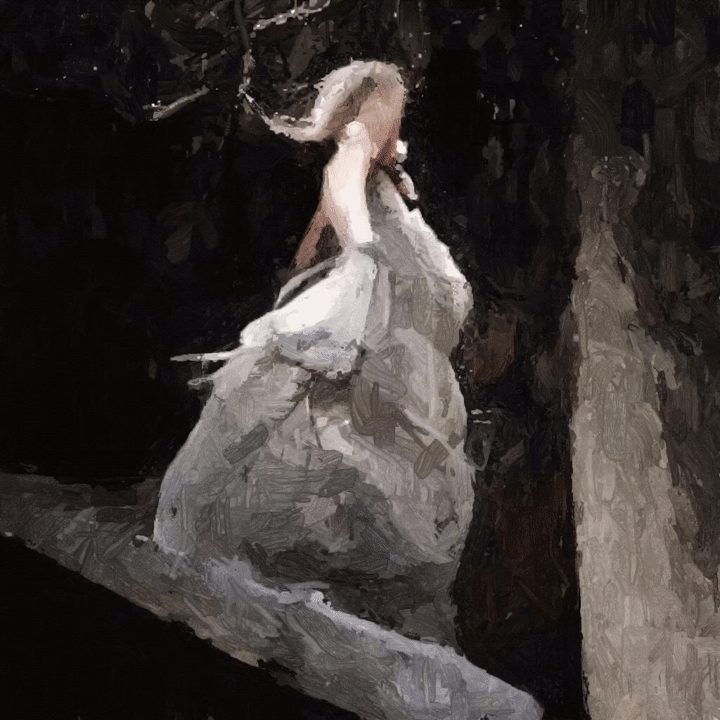IMN #17 — Claire Silver

It's Monday Night #17
Tonight, let’s share thoughts about @ClaireSilver12’s work. In the conclusion of her Cyborg Manifesto, Donna Haraway writes: "I would rather be a cyborg than a goddess". @ClaireSilver12's work proves that you can be both.
Let me elaborate.
But let's start by taking a look at her pieces. You can see different techniques, creative processes: collage, photography, oil or acrylic painting, but also with digital tools like breeding or digital illustration applications.
@ClaireSilver12 is only interested in solitary figures. Even when there are two or three figures, there is coexistence between them but not relationship. They are beings deprived of all company, captured in unreadable, deliberately unbalanced postures.
We find ourselves on the disturbing edge of the human and the non-human: a lonely character, waiting for an improbable and indeterminate event, who wanders in a metaphorical, abstract and disconnected space.
In @ClaireSilver12's works, there is a kind of warmth that fails to diffuse, yet distorts the lines of colour and slightly bends the space around the bodies.
Most of her works are hybrid objects, which cannot be easily categorized.
They are, on the whole, of great immobility and coldness: dark colours, poorly drawn contours, chromatic thickness, intermingling of materials.
But some pieces are sometimes animated by an incandescent pulse, helped by the use of a filter that gives the image an ember-like texture and creates an effect of tonal instability in her painting.
The composition is frozen, leaving no room for movement, but it finds its own dynamism in the shimmering or flashing of the flesh.
All shades of abandonment can be found in @ClaireSilver12's paintings: distress, despair, absurdity, terror, etc.
Her work plunges us with great mastery into an uninhabitable twilight, where bodies absorb light but do not radiate.
She sometimes chooses backlighting: the little light that illuminates the scene is precisely what makes the human figure imperceptible, hidden, anonymized.
From the point of view of pictorial tradition, @ClaireSilver12 uses light in a counter-intuitive way; not to reveal the sensitive singularities of a scene, but rather to hide and dilute them in indistinct volumes.
We know the old technique of chiaroscuro: roughly, creating light values by controlling the contrast with the dark areas of the painting.
I believe that @ClaireSilver12 explores an entirely different path: the tension between light and dark does not create a revealing contrast but a blurring of represented identities.
But, on the other hand, it is only by deepening the loneliness to the point where hope is no longer allowed, that it may become possible to be saved again.
Let us remember Beckett: it is by exhausting the wait for Godot that he will perhaps finally arrive, when all the combinations have been tried, when all the moves have been made.
It is the figure of absolute wait: wait without any expectation, wait as pure openness to what might happen at the end of time.
But @Claire Silver12's aesthetic obeys a principle of stylisation of solitude: if there are few faces in her universe, it is because she seeks above all to sculpt attitudes, postures, ways of living. Styles.
Even in an artificial paradise, when everything is in decline, there is still a truth in clothing, in the way one carries one's head or looks. The body wraps itself in signs, in an ornament that both reveals it and leads to its disappearance.
It is somehow the cold beauty of fashion icons, pale, enigmatic, sickly and diaphanous. Nevertheless, in @ClaireSilver12's painting, "fashion" is not a way of symbolizing social prestige or sexualizing the female body, it is the art of creating hybrid identities.
@ClaireSilver12's painting is populated by cyborgs, she turns the body into a space of transition between realities that we usually oppose: the human and the machine, the skin and the fabric, the organic and the mechanical.
The fashionable body is a gender-confusing body that takes us across the border between nature & culture.
So, on the 1 hand, what was double (natural/artificial) is reunited; but on the other hand, what was one is split: the twin or twinning pattern is fundamental in her work.
Firstly, because she acknowledges the doubling of artistic production between the physical and the virtual work. Secondly, because she works in collaboration with an artificial intelligence and part of her creative process is delegated to the machine's brain.
Finally, because @ClaireSilver12 puts 7% of her face into each of the portraits, which are therefore both self-portraits and portraits of another one.
Interesting proportion: both negligible - 93% of the rest of the face differs from the artist's - and crucial - the family resemblance between all the portraits stems from this common resemblance.
@ClaireSilver12 hijacks the old genre of the self-portrait: the artist fades away, she is no longer the privileged model, but she is a fragment of code spread everywhere by an artificial intelligence.
In other words, Claire Silver attempts to translate the power of the ongoing cultural and technological revolution into pictorial language.
She gives shape to a new sensibility - a chromatics, a composition of space, a mode of figuration - that shows how this revolution affects her body, her frames of perception and the norms of artistic creation.
@ClaireSilver12's art does not reflect the world, it reflects the way digital art reflects the world - and transforms contemporary subjectivities.
She explores the non-fungible token asperities, formal and plastic potentialities of blockchain as a medium: emergence of a new aura and transcendence within a technology that nevertheless assumes infinite reproducibility.